Although not much into knives, as a whole, I’ve found myself always carrying one or another to the field while participating, as a guest journalist, in military maneuvers all around Brazil along decades. Even if never used for any throat-cutting, sentinel-dispatching action, my blades did frequently prove very handy to cut tree branches to make improvised clothes hangers in camps, open food cans, help transform pineapples into valuable hydrating complements to field rations, turning barbecued meats (yes, different kinds…) into added-on proteins to help me keep on following the younger guys, etc.. Since I’ve figured that most of the times I was carrying a locally-made IMBEL – Indústria de Material Bélico do Brasil product, I’ve decided to show and briefly describe to TFB readers some of the blades that have come out of the company’s Fábrica de Itajubá (Itajubá Factory), in Minas Gerais State, in the last 40-or-so years. It’s interesting to notice that most people expect gun writers to automatically become blade experts, but this is not my case: I’m just a plain, average knife user. Enjoy the pictures, though.
The FC-IA2

Even if bayonets may be considered an idiosyncrasy in modern warfare, the fact that they also double as utility/combat knives is appreciated. The 5.56x45mm IMBEL IA2 rifle is seen here with this add-on item.
When IMBEL started developing its 5.56x45mm and 7.62x51mm IA2 rifles in 2008-2010, the opportunity was also taken to create a bayonet that could double as a general utility/combat knife. The result is the FC-IA2, which is not only accompanying the weapons being supplied to the Brazilian Army, but is also finding good acceptance in its utility roles with the local Armed and LE Forces, plus with the general public, since it is commercially available direct from the manufacturer and from private dealers.

AISI 1070 carbon steel, a popular material in military cutlery, is employed in its construction, the flat ground blade being hardened to about 50 in the Rockwell C scale, this being said to represent a good combination of torsion/bending characteristics. The handle is made of molded polyamide, being topped by a flat steel surface to allow hammering functions, a lanyard hole being provided there. All the metal parts are phosphate coated for corrosion resistance.

In addition to the belt loop (seen here with the inner Velcro straps separated), the sheath includes a click-opening/closing metal clip for attachment purposes.
Particular design attention was given to the polyamide sheath, which features a water draining opening that doubles as a lanyard hole. The reinforced nylon belt loop, with Velcro strips inside to keep it tightly closed when not used, is complemented with a quick-attach/release metal clip for belt or backpack use.
FC-IA2 SPECIFICATIONS: total length, 296mm; blade length, 178 mm; blade thickness, 4.5mm; blade width, 33mm; weight, knife alone, 380g; weight with sheath, 550g.

Size comparison of the FC-IA2 and the FC-AMZ knives.
The FC-AMZ

The FC-AMZ is seen here fitted to a 7.62x51mm IMBEL IA2 rifle. Yup, they’ve given the weapon the same designation of the 5.56x45mm model.
The FC-AMZ (from Amazonas) is a larger version of the FC-IA2 model, equally compatible with use as a bayonet, though this capacity is present, of course, as a “just-in-case” feature. It’s no small coincidence that most of its characteristics were either suggested or tested by the guys from Brazilian Army’s CIGS – Centro de Instrução de Guerra na Selva (Jungle Warfare Training Center), located in Manaus, Amazonas State, with additional inputs from SpecOps personnel. Construction material and details for the knife and sheath are duplicates from those of the smaller counterpart.
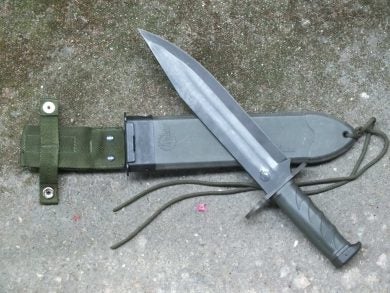
Dimensions and weight of the FC-AMZ were basically specified to meet the requirements of Brazilian Army’s Jungle Warfare Training Center.
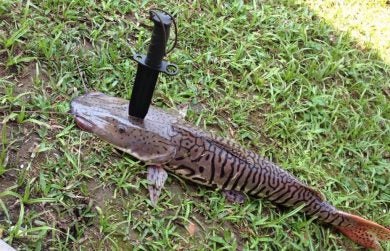
The AMZ knife is seen here in a non-military application… (Photo Credit: Alexander Olive)
FC-AMZ SPECIFICATIONS: total length, 365mm; blade length, 247mm; blade thickness, 4.5mm; blade width, 47mm; weight, knife alone, 520g; weight with sheath, 780g.
The Mk.2 Trench Knife

Author’s decrepit Trench Knife after a long career of field use and abuse. Sheath is the all-leather, commercial version that was given a war paint.
Produced at IMBEL’s Fábrica de Itajubá for many years (1980s-1990s), the locally-called Faca de Trincheira Mk.2 (Mk.2 Trench Knife) is an unsophisticated — but highly popular — article still found among the everyday items carried by military and LE guys in Brazil. My battered example was once (but never authorized by me) mishandled by a guy who started using a motorized sharpening wheel to “fix it” before he was stopped, the scars remaining to this day. The knife features a leather-rings handle and a no-frills sheath of the same material.
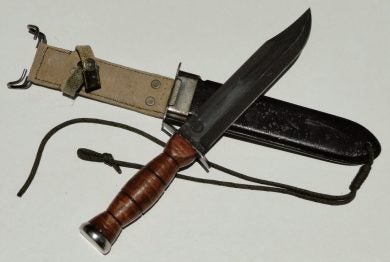
A military issue IMBEL Trench Knife with different sheath.
TRENCH KNIFE SPECIFICATIONS: total length, 320mm; blade length, 185mm; blade thickness, 3mm; blade width, 30mm.
The Survival/Hunter Knife
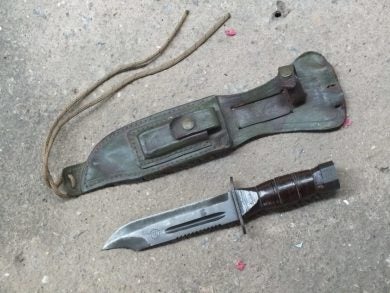
The Caçador (Hunter) knife with its leather sheath painted in a military style. Note sharpening stone compartment.
In the 1970s, a knife called Caçador (Hunter) was commercially marketed in Brazil by IMBEL, while at the same time being offered to the Brazilian Air Force as a survival tool (never officially accepted). It featured a leather-rings handle and a leather sheath containing a small sharpening stone compartment, something pretty common in the popular Ontario Air Force Survival Knife and others. The sawback portion is 45mm long.
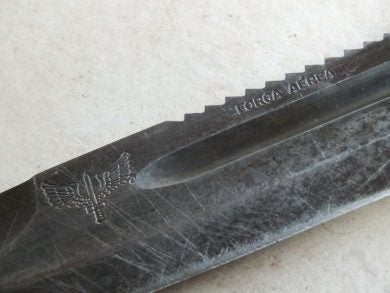
A close-up view of author’s rare and much used specimen shows that it sports a Brazilian AF logo (winged sword) and FORÇA AÉREA (Air Force) markings, indicating its earlier survival knife intentions.
SURVIVAL/HUNTER KNIFE SPECIFICATIONS: total length, 245mm; blade length, 140mm; blade width, 5mm; blade thickness, 5mm; weight, 240g.
The Fireman’s Knife (Faca de Bombeiro)

The IMBEL Faca de Bombeiro.
In the mid-1980s, the company made an experimental batch of knives intended to be used by Brazilian fire departments for general rescue duties, but it was never adopted as such. The huge carbon steel blade had a saw back, a wirecutter slot, and a claw slot at the tip, while the handle was wooden. The surviving examples have now become collectors’ items.
FIREMAN’S KNIFE SPECIFICATIONS: total length, 340mm; blade length, 225mm; blade thickness, 10mm; weight, 820g.
 Your Privacy Choices
Your Privacy Choices
